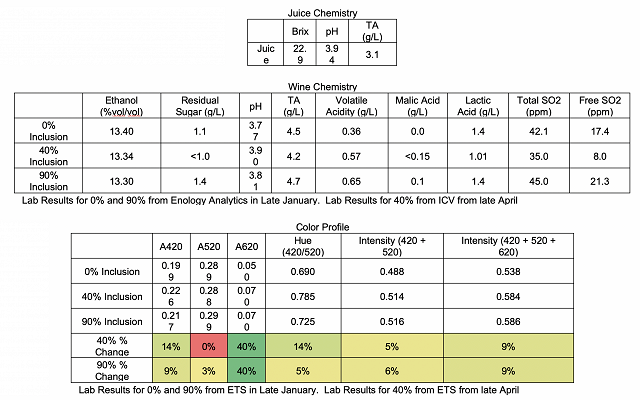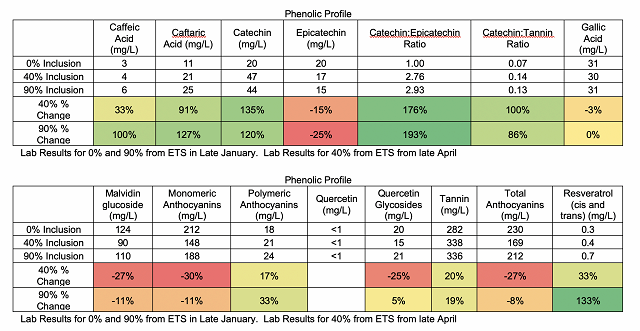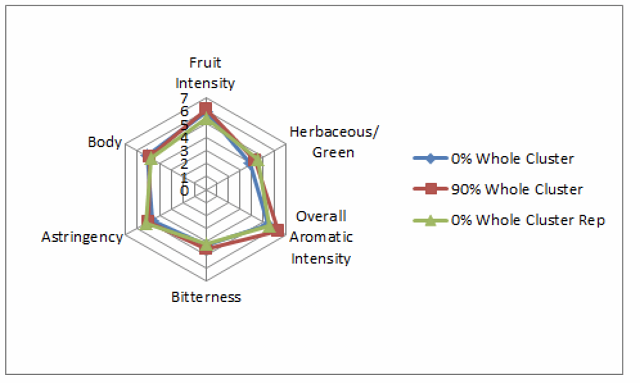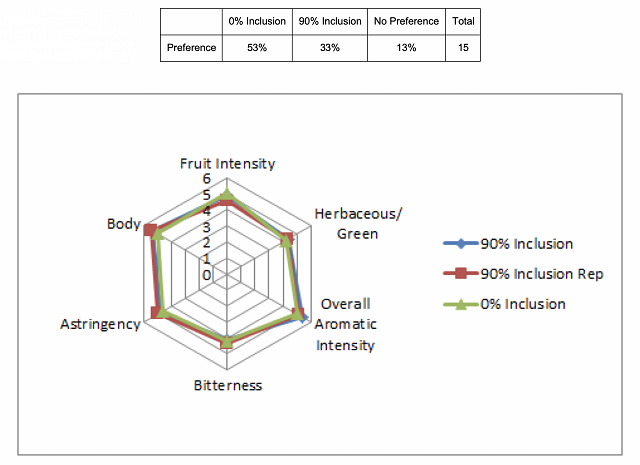Whole Cluster Inclusion in Cabernet Franc Fermentations (2016)
Matthieu Finot
King Family Vineyards
Summary
This study examines the impact of whole cluster/stem inclusion on the sensory and chemical profile of Cabernet Franc. Cabernet Franc was harvested from the same vineyard block on the same day and processed identically except that stem inclusion was performed so that either 100% of the fruit was destemmed but not crushed, 60% of the fruit was destemmed but not crushed (40% added as whole clusters), or 10% of the fruit was both destemmed and crushed and the other 90% was added as whole clusters. All other treatments were the same. The 40% Inclusion treatment was not tasted. Whole cluster inclusion did not affect wine chemistry. Color intensity and hue were both increased at 40% and 90% whole cluster inclusion. Cinnamic acids, catechin, tannin, and polymeric anthocyanins were also increased with 40% and 90% inclusion (although polymeric anthocyanins were not very different). Epicatechin and anthocyanins were lowered by 40% and 90% whole cluster inclusion. The results for 40% inclusion were taken at different time points, however, so may not be entirely representative. Judges found the wines to be significantly different, but there were no strong preferences for one treatment over another. 90% inclusion had a slight tendency to have higher Overall Aromatic Intensity and Fruit Intensity, but this was not seen at all tastings. More studies should be performed on whole cluster and stem inclusion to determine how to best vinify different treatments. This is especially true with regard to microbial stability, as well as finding optimal ranges of cluster/stem inclusion based on desired styles.
Introduction
The role of whole cluster and stem inclusion in winemaking is very controversial. Whole cluster fermentation is often used in Burgundian Pinot noir and is thought to add complexity to the wine (Weston 2000). Whole clusters are thought to round out and complement the low tannin in Pinot noir, and the flavors of Syrah can be complemented by stems (Meisner 2016). However, whole cluster inclusion also results in stems being added to the wine. Stems can enhance structure and wine quality sometimes, but also can add vegetal aromas (Ribèreau-Gayon et al. 2006). In certain cases, these vegetal aromas can also be perceived as spicy, and may act as a counterbalance to overly fruity qualities. Vegetal aromas and tannin additions may also balance out some carbonic maceration character which is found in whole cluster inclusion, which enhances ester aromatics, extends fermentation after pressing, and reduces the contribution of seed tannin. Stem inclusion is less common for Bordeaux varieties because of their already high levels of pyrazine (Meisner 2016). The reticence to use stems due to pyrazine characteristics in certain varieties is likely unfounded, due to cultural practices and climatic conditions which can greatly lower pyrazine character. Stems tend to lower alcohol content, decrease titratable acidity, and increase pH (due to high potassium levels). Stems can contribute a large amount of tannin to wine. Additionally, stems tend to decrease color intensity by adsorbing anthocyanins (Ribèreau-Gayon et al. 2006; Reshef et al. 2016). Finally, wines made with stem inclusion tend to have higher color stability over time (Ribèreau-Gayon et al. 2006). These results vary, however (Ribèreau-Gayon et al. 2006), and are dependent on many other factors, such as extraction kinetics, maceration practices, the level of crushing in the grapes, grape variety, and possibly stem maturity. Whole cluster and stem inclusion require much more thorough study before any hard conclusions can be drawn. This study examines the impact of whole cluster inclusion on Cabernet Franc wine.
Results and Discussion
Microbial issues arose during the fermentation and aging of these wines, especially with 90% whole cluster inclusion. This is likely due to the difficulty of submerging the grapes during punchdowns, and exposure to air. Whole cluster inclusion did not affect wine chemistry. Color intensity and hue were both increased at 40% and 90% whole cluster inclusion. Cinnamic acids, catechin, tannin, and polymeric anthocyanins were also increased with 40% and 90% inclusion (although polymeric anthocyanins were not very different). Epicatechin and anthocyanins were lowered by 40% and 90% whole cluster inclusion. The results for 40% inclusion were taken at different time points, however, so may not be entirely representative.


For the triangle test at the April 12 tasting, of 21 people who answered, 14 people chose the correct wine (67%), showing a statistically significant difference between wines (p<0.01). These wines were voted to have an average degree difference of 6.1 (out of 10), suggesting that the wines were fairly different. In general, there were no strong preferences among people who answered correctly. Descriptive analysis did not show any strong tendencies with the descriptors used in this study. This may be in part due to inadequacy of the term “Fruit Intensity” for this study, since the 90% whole cluster inclusion had more estery fruit notes whereas the other wine had “riper” fruit notes. There appeared to be a slight tendency for the 90% whole cluster wine to have higher Overall Aromatic Intensity and Fruit Intensity. Additionally, the 90% whole cluster inclusion was described as having a mild Brettanomyces aroma to some judges (although not others).


For the triangle test, of 20 people who answered, 16 people chose the correct wine (80%), showing a statistically significant difference between wines (p<0.001). These wines were voted to have an average degree difference of 5 (out of 10), suggesting that the wines were moderately different. In general, there were no strong preferences among people who answered correctly. No strong trends could be seen with the descriptors used in this study on the April 26 tasting. 90% Inclusion had a slight tendency to increase Body.

Overall, judges found the wines to be significantly different, but there were no strong preferences for one treatment over another. 90% inclusion had a slight tendency to have higher Overall Aromatic Intensity and Fruit Intensity, but this was not seen at all tastings. The descriptors used were not adequate to fully distinguish the differences. More studies should be performed on whole cluster and stem inclusion to determine how to best vinify different treatments. This is especially true with regard to microbial stability, as well as finding optimal ranges of cluster/stem inclusion based on desired styles.
Methods
2.66 tons of MT Cabernet Franc were harvested on 10/6/2016 and destemmed and crushed into 3 T-Bins in the following treatments:
- T bin 1 - 100% of the fruit was de-stemmed but not crushed
- T bin 2 - 60% of the fruit was de-stemmed but not crushed; 40% (by wt) was added as whole clusters
- T bin 3 - 10% of the fruit was de-stemmed and crushed; 90% (by wt) was added as whole clusters
Each treatment received 3g/hL sulfur dioxide during crush. All three treatments were inoculated with ES488 at 13.5 g/hL. On 10/7, 1.25g/L tartaric acid and 0.3 g/L malic acid was added to each treatment. On 10/8, 5.7g/hL Lafase HE Grand Cru was added to each treatment. On 10/14 10g/L sugar and 15g/hL Fermoplus Premier Cru were also added to each treatment.
All treatments were pressed on 10/31 to ensure equal maceration times between treatments. These were then racked off lees into identical neutral barrel on 11/1, and treated with Enartis Lysozyme at 20g/hL on 11/3. On 11/7, the 90% whole cluster inclusion treatment also received 11g/hL Enartis Lysozyme. At 11/9, each treatment received No Brett at 8.8g/hL, and on 11/18 each treatment received 6.6g/hL sulfur dioxide. On 1/13/2017 each treatment received 0.66g/L tartaric acid and 2.2g/L sulfur dioxide, and on 1/16 each treatment received 13.3 g/hL Stab Micro.
This project was tasted on April 12 and April 26. The 40% Inclusion treatment was not tasted. For the triangle test and preference analysis, anybody who did not answer the form were removed from consideration for both triangle, degree of difference, and preference. Additionally, anybody who answered the triangle test incorrectly were removed from consideration for degree of difference and preference. Additionally, any data points for preference which did not make sense (such as a person ranking a wine and its replicate at most and least preferred, when they correctly guessed the odd wine) were removed.
In order to balance the data set to perform statistical analysis for descriptive analysis on the April 12 tasting, any judge who had not fully completed the descriptive analysis ratings were removed. In order to then make the amount of judges between groups equivalent, one judge from group 1 was eliminated. This resulted in a final data set of 3 groups, each with 5 judges (considered as replications within groups, and groups were considered as assessors). Data was analyzed using Panel Check V1.4.2. Because this is not a truly statistical set-up, any results which are found to be statistically significant (p<0.05) will be denoted as a “strong trend” or a “strong tendency,” as opposed to general trends or tendencies. The statistical significance here will ignore any other significant effects or interactions which may confound the results (such as a statistically significant interaction of Judge x Wine confounding a significant result from Wine alone). The descriptors used in this study were Fruit Intensity, Herbaceous/Green, OVerall Aromatic Intensity, Bitterness, Astringency, and Body.
The same procedures for data analysis were used on the April 26 tasting. In order to balance the data set for descriptive analysis, one judge was transferred from group 1 to group 3 and another judge was eliminated from group 1. This resulted in a final data set of 3 groups, each with 7 judges.
References
Meisner, M. 2016. Fermentation 101: The case for whole clusters. Last Bottle. http://blog.lastbottlewines.com/education/whole-clusters/. Accessed 2/10/2017.
Reshef, N., Morata, A., and Suárez-Lepe, J.A. 2016. Towards the use of grapevine by-products for reducing the alcohol content of wines. Biointerface Research in applied Chemistry. 6:1531-1537.
Ribèreau-Gayon, P., Dubourdieu, D., Donèche, B., and Lonvaud, A. 2006. Handbook of Enology, Volume 1: The Microbiology of Wine and Vinifications 2nd Edition. John Wiley & Sons. Chichester, West Sussex, England.
Weston, L.A. 2000. Grape and wine tannins and phenolics – their roles in flavor, quality and human health. 29thAnnual New York Wine Industry Workshop. https://ecommons.cornell.edu/handle/1813/39812. Accessed 2/7/2017.
